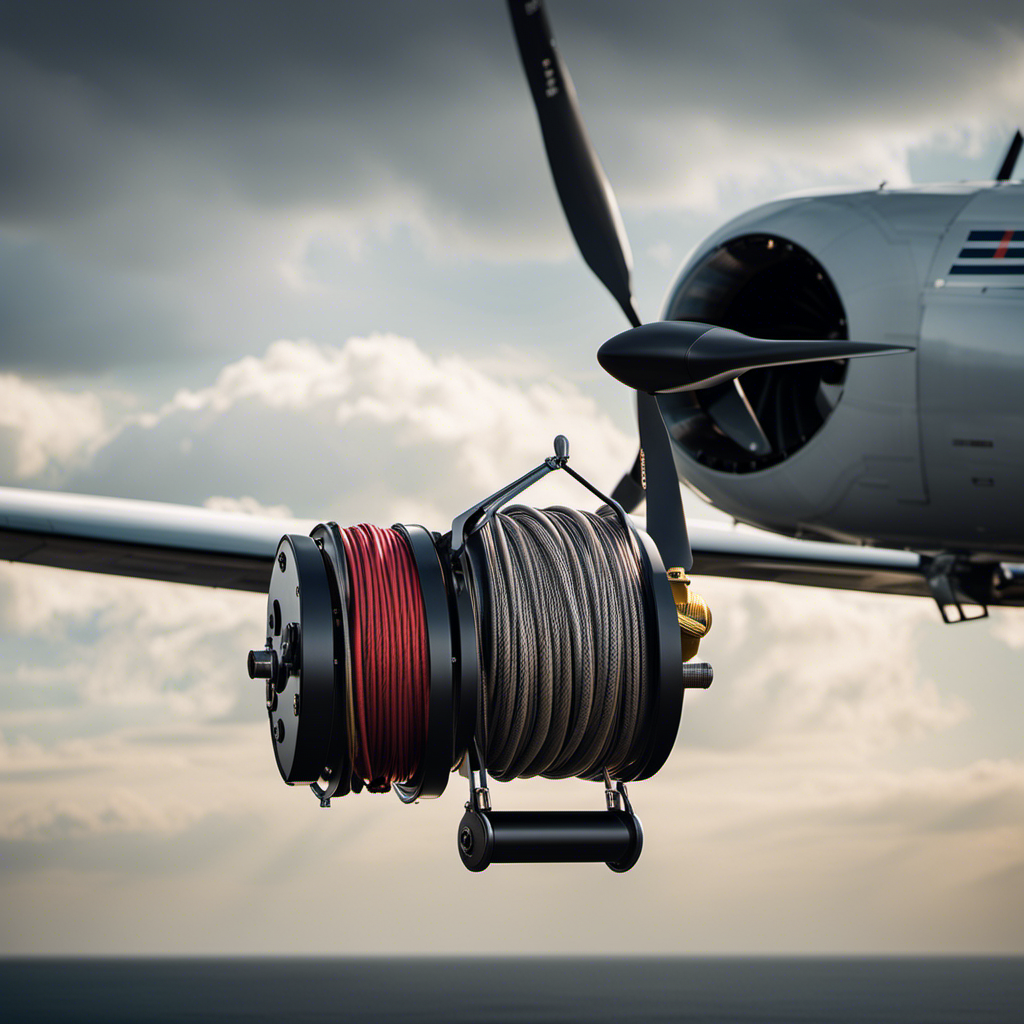Being a glider pilot, the complex details of the glider winch have always captivated me.
Have you ever wondered how this powerful contraption propels gliders into the sky?
In this article, we will delve into the inner workings of a glider winch, exploring its basic components, the role of the operator, and the benefits it provides.
Join me on this technical journey as we unravel the mysteries behind this essential tool in the world of gliding.
Key Takeaways
- Glider winches require comprehensive training for operators, including malfunction prevention and troubleshooting procedures, effective response in emergencies, and ensuring safety during operations.
- Emergency procedures must be in place, including pilot assessment and determination of the safest course of action, cost-effective and efficient procedures for quick decision-making, and minimizing impact on aircraft and occupants.
- Glider winches offer benefits such as cost-effectiveness, adaptability to various weather conditions and terrains, lower initial investment compared to other launch methods, and efficient tow to desired altitude with high launch speed.
- Limitations of glider winches include weather considerations, terrain challenges, reliance on external assistance for safe landing, and careful assessment and planning for smooth and safe operations.
The Basic Components of a Glider Winch
To understand how a glider winch works, you’ll need to know the basic components involved.
The first essential component is the power source, which provides the necessary energy to operate the winch. The power requirements vary depending on the size and weight of the glider being launched.
The next crucial component is the winch cable, which is made of strong, durable materials such as steel or synthetic fibers. This cable is securely attached to the winch drum and extends out to the launch point.
As the winch is activated, the cable is rapidly retracted, generating the necessary force to launch the glider into the air.
Understanding the power source is fundamental to comprehending the entire operation of a glider winch, as it plays a vital role in providing the energy needed for a successful launch.
Understanding the Power Source
Take a moment to understand how the power source of a glider winch operates.
The power generation in a glider winch is achieved through a mechanical operation. A typical glider winch is equipped with a gasoline or diesel engine that drives a large drum, usually located at the rear of the winch.
This drum is responsible for winding and unwinding the cable that will launch the glider. As the engine runs, it powers the drum, which in turn rotates and pulls the cable. The rotation of the drum generates the necessary force to launch the glider into the sky.
Now, let’s delve into the next section, where we will explore the crucial steps involved in preparing for launch.
Preparing for Launch
Before launching a glider, it’s crucial to properly attach it to the winch to ensure a safe and successful takeoff. The attachment process involves securing the glider’s tow rope to the winch’s drum and making sure it is properly tensioned.
Additionally, it’s important to follow safety precautions such as wearing protective gear, checking the glider for any damage or malfunctions, and communicating effectively with the winch operator to ensure a smooth launch.
Attaching the glider to the winch
Attach the glider securely to the winch before you begin the launch process. This is a crucial step in ensuring glider winch safety and proper functioning of the winch system.
To attach the glider to the winch, follow these glider winch techniques:
- Position the glider in front of the winch drum, aligning the release mechanism with the tow rope.
- Connect the tow rope to the release mechanism, ensuring a secure attachment.
- Double-check all connections and ensure they are tight and properly fastened.
By following these steps, you can ensure that the glider is securely attached to the winch, minimizing the risk of any accidents or failures during launch.
Now that the glider is attached, let’s move on to discussing the safety precautions that should be taken before starting the winch.
Safety precautions
Now that you’ve securely connected the glider to the winch, it’s important to ensure your safety by following these precautions.
Before every flight, it’s essential to undergo proper emergency training. This includes familiarizing yourself with emergency procedures and practicing them regularly.
Additionally, thorough equipment maintenance is crucial for safe operations. Regular inspections should be performed on the winch and all related equipment to ensure they’re in optimal working condition. This includes checking the cables, hooks, and winch drum. Any signs of wear or damage should be addressed immediately.
By prioritizing emergency training and equipment maintenance, you can minimize the risk of accidents and ensure a safe glider winch operation.
Now, let’s delve into the launch process.
The Launch Process
To launch the glider, you’ll need to communicate with the winch operator and prepare for takeoff. First, ensure that the glider is properly connected to the winch cable and that all control surfaces are free and functioning correctly. Then, coordinate with the winch operator to establish a clear communication system, using hand signals or radios.
Once ready, release the brakes and signal the winch operator to start the winch. As the winch starts, the glider will rapidly accelerate down the runway. Keep a steady hand on the controls to maintain a straight path during the launch.
Finally, as the glider gains altitude, smoothly transition from the winch to soaring flight. This careful launch process ensures a safe and efficient takeoff for the glider.
Moving on to the role of the winch operator…
The Role of the Winch Operator
As the winch operator, you’ll be responsible for safely controlling the speed and tension of the winch cable during the glider launch. This role requires specialized training to ensure smooth and efficient operations.
Winch operator training covers various aspects, including understanding the winch system, its components, and maintenance procedures. Additionally, communication protocols are crucial for effective coordination between the winch operator and the glider pilot. Clear and concise instructions must be conveyed to synchronize the launch process.
It is essential to maintain constant communication to address any changes or issues that may arise during the launch. Safety measures and emergency procedures are integral to the winch operator’s responsibilities, ensuring the well-being of everyone involved. These protocols are designed to handle any unforeseen circumstances and are vital for a successful glider launch.
Safety Measures and Emergency Procedures
When it comes to gliding, safety is of utmost importance. That’s why it’s crucial to have contingency plans in place for any malfunctions that may occur during a flight. These plans ensure that we are prepared to handle any unexpected situations and minimize risks.
Additionally, emergency landings are a critical aspect of gliding safety. Proper training and procedures allow us to safely land the glider in case of emergencies, ensuring the well-being of both the pilot and the aircraft.
Contingency plans for malfunctions
In case of malfunctions, the glider winch has built-in safety mechanisms to ensure a smooth landing. Regular maintenance and inspections are crucial to prevent malfunctions. Troubleshooting procedures are in place to quickly identify and fix any issues that may arise.
Here are four key aspects of the contingency plans for malfunctions:
-
Safety Checks: Before each flight, thorough pre-flight checks are conducted to ensure that the winch is in proper working condition.
-
Emergency Stop: The winch operator has immediate access to an emergency stop button, allowing them to halt the winch operation instantly in case of any abnormality.
-
Backup Systems: The winch is equipped with redundant systems, such as backup power sources and multiple braking mechanisms, to ensure continued operation in case of a primary system failure.
-
Training: Winch operators undergo comprehensive training on malfunction prevention and troubleshooting procedures, enabling them to respond effectively in emergency situations.
By implementing these measures, the glider winch is equipped to handle malfunctions with efficiency and safety.
Transitioning into the subsequent section about ’emergency landings,’ we will now explore the procedures for handling unexpected situations during flight.
Emergency landings
The first step in handling emergency landings is for the pilot to assess the situation and determine the safest course of action. In the event of an emergency, the pilot must follow a set of emergency procedures to ensure the safety of all aboard.
These procedures are designed to be cost-effective and efficient, allowing for quick decision-making and action. By following these procedures, the pilot can effectively handle emergency situations while minimizing the impact on both the aircraft and its occupants.
However, it’s important to note that emergency procedures are not foolproof and may have limitations. One such limitation is the reliance on external assistance, such as glider winches, to safely land the aircraft. Glider winches offer benefits in terms of rescue capability, but they also have limitations that must be considered.
The Benefits and Limitations of Glider Winches
When considering the benefits and limitations of glider winches, two key factors to consider are the cost-effectiveness compared to other launch methods and the considerations for weather and terrain.
Glider winches are widely regarded as a cost-effective launch method, as they require minimal maintenance and have low operating costs.
Additionally, the use of glider winches is versatile and can be adapted to various weather conditions and terrains, making it a reliable option for glider launches in different environments.
Cost-effectiveness compared to other launch methods
Compared to other launch methods, a glider winch is more cost-effective. A cost benefit analysis reveals that the initial investment to set up a winch launch system is significantly lower than other methods such as aerotow or self-launch.
The winch itself is a simple device consisting of a drum, cable, and a powerful engine. Its launch efficiency is impressive, as it can quickly and efficiently tow a glider to the desired altitude. The winch’s ability to generate a high launch speed allows for shorter launch distances, reducing the need for extensive runway infrastructure.
Furthermore, the winch’s compact size and portability make it suitable for a variety of launch sites.
Now, let’s consider the crucial factors of weather and terrain considerations.
Weather and terrain considerations
Consider the impact of weather and terrain on your glider winch operations. When it comes to weather considerations, factors such as wind speed and direction play a crucial role in determining the safety and success of a winch launch. Strong crosswinds can create turbulence, making it challenging to maintain control of the glider during takeoff and climb. Additionally, variations in temperature and air density can affect the performance and efficiency of the winch system.
As for terrain challenges, the presence of obstacles like trees, hills, or buildings can limit the available launch direction and affect the cable angle. Uneven or soft ground can also pose difficulties for the winch vehicle and its ability to generate sufficient traction. These weather and terrain factors require careful assessment and planning to ensure smooth and safe glider winch operations.
Moving on to innovations in glider winch technology…
Innovations in Glider Winch Technology
One of the latest innovations in glider winch technology is the use of carbon fiber cables. These lightweight yet incredibly strong cables have revolutionized the industry, offering several advantages over traditional steel cables.
Carbon fiber cables are not only lighter, which reduces the overall weight of the winch system, but they also have a higher tensile strength. This means that they can withstand greater forces without breaking, allowing for more powerful launches.
Additionally, carbon fiber cables have lower aerodynamic drag, which improves the efficiency of the winch and increases the speed and altitude that can be achieved during a launch.
These innovations in glider winch technology are just the beginning, as future developments may include even lighter and stronger materials, as well as further improvements in aerodynamic design. With these advancements, the future of glider winches looks promising, offering even greater performance and efficiency.
The Future of Glider Winches
Looking ahead, you’ll be excited to see the future advancements in glider winch technology. As technology continues to evolve, glider winches are expected to become more efficient and environmentally friendly. These advancements will not only enhance the performance of glider winches but also reduce their environmental impact. In the table below, I have summarized some potential future advancements and their corresponding environmental benefits:
| Future Advancements | Environmental Impact |
|---|---|
| Increased power output | Reduced launch time |
| Lightweight materials | Lower energy consumption |
| Improved safety features | Minimized noise pollution |
These advancements will not only improve the overall experience of glider winch launches, but also contribute to a more sustainable and eco-friendly aviation industry. The future of glider winches looks promising, with advancements aimed at maximizing efficiency and minimizing environmental impact. Now, let’s move on to experiencing a glider winch launch without delay.
Experiencing a Glider Winch Launch
Experiencing a glider winch launch is an exhilarating and adrenaline-filled adventure. The power of the winch as it rapidly reels in the cable, propelling the glider forward, is truly awe-inspiring. But amidst the excitement, it is crucial to prioritize glider winch safety and understand the intricacies of glider winch operation.
Here are five key aspects to consider:
-
Cable tension: Maintaining proper tension in the cable is essential for a successful launch and to prevent any mishaps during the process.
-
Launch angle: The glider must be positioned at the correct angle for a smooth and efficient takeoff.
-
Communication: Clear and concise communication between the winch operator and the glider pilot is crucial for a safe launch.
-
Pre-flight checks: Thorough pre-flight checks ensure that all systems are functioning properly and reduce the risk of any issues during the launch.
-
Emergency procedures: Understanding and practicing emergency procedures is vital to handle any unforeseen circumstances that may arise during a glider winch launch.
Frequently Asked Questions
How long does it take to set up a glider winch?
Setting up a glider winch can be a labor-intensive process that requires a significant amount of time and effort. Various steps, such as assembling the equipment, securing the winch, and connecting cables, must be meticulously performed for a successful setup.
What is the maximum altitude that a glider can reach using a winch?
The maximum altitude a glider can reach using a winch depends on the winch efficiency. With a highly efficient winch, a glider can reach altitudes of several thousand feet, allowing for longer and more adventurous flights.
Are glider winches used in competitive gliding events?
Gliders winches are essential in competitive gliding events due to their competitive advantages. Safety regulations ensure smooth operation. They are a game-changer, allowing gliders to reach extraordinary heights and compete at levels that were once unimaginable.
How much force does a glider winch generate during launch?
The glider winch generates a significant amount of force during launch, typically around 2,000 to 3,000 pounds. This force is carefully controlled to ensure the safety of the glider and the pilot. Glider winch safety measures are in place to prevent excessive force or sudden acceleration.
Can a glider winch be used in all weather conditions?
In all weather conditions, safety considerations are paramount for glider winch operations. Ground crew play a crucial role in ensuring safe launches, monitoring wind and runway conditions, and communicating with the pilot.
Conclusion
In conclusion, after thoroughly investigating the theory and mechanics behind glider winches, it is clear that these innovative devices play a crucial role in launching gliders into the sky.
With their basic components, power sources, and skilled operators, glider winches provide a precise and efficient method for launching gliders.
While there are some limitations, ongoing advancements in glider winch technology promise an exciting future for this vital aspect of glider aviation.
Experiencing a glider winch launch firsthand is truly a thrilling and awe-inspiring experience.
With a heart that soars as high as the skies, Aria, affectionately known as “Skylark,” is the driving force behind Soaring Skyways. Her journey into the gliding world began as a young dreamer gazing up at the soaring birds, yearning to experience the weightlessness and freedom they embodied. With years of experience both in the cockpit and behind the scenes, Aria’s commitment to the gliding community is unwavering.










